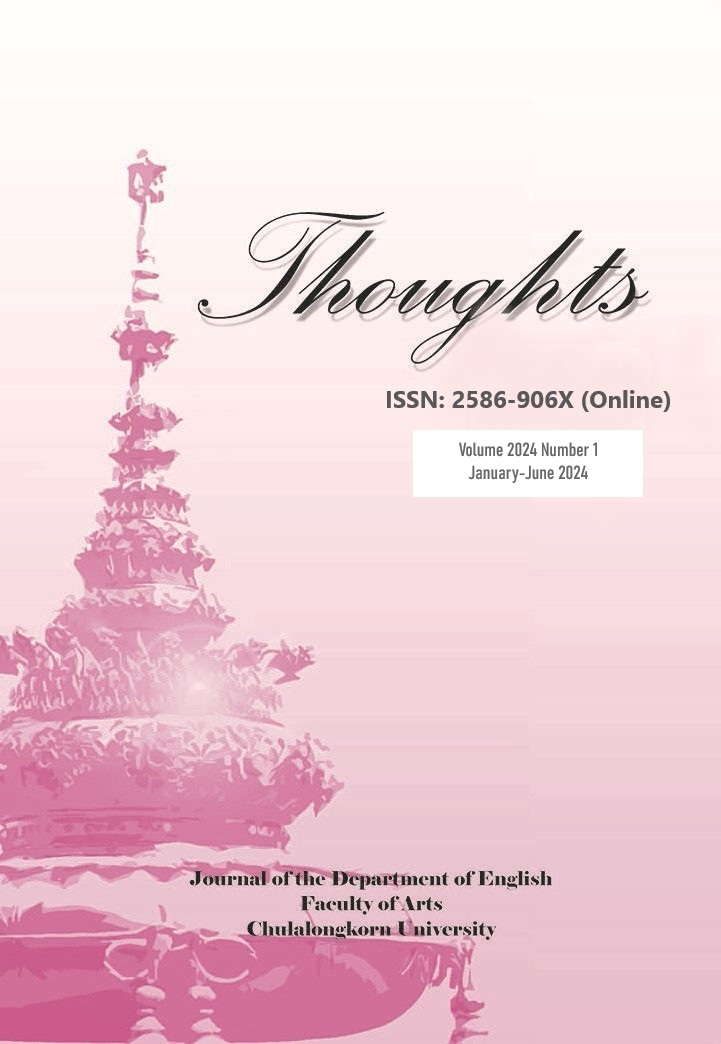Making Fun of the Make-believe: How The Girl Who Kicked the Hornet’s Nest Takes Revenge on the Discourse of Power
DOI:
https://doi.org/10.58837/CHULA.THTS.2024.1.2Keywords:
The Girl Who Kicked the Hornet’s Nest; Michel Foucault; discourse of power; Jean Baudrillard; mimicryAbstract
This study investigates the courtroom section in Stieg Larsson’s The Girl Who Kicked the Hornet’s Nest to explore how the discourse of power is exploited to privilege some and exclude others, and to explain how such institutionalised power can be mimicked, ridiculed and ultimately made irrelevant through cunning courtroom strategies and shifty postmodern theories. The results reveal that scientific knowledge is essentialised and monopolised by the state through practices that brand the female protagonist as insane and deprive her of the most basic form of legal rights. In addition, sanity and insanity alike are shown to be mere representations of the imaginary as they are both mimicable; the sane can act insane and vice versa. Their truth value, consequently, becomes indistinct and unjustifiable. Essentially, the truth that the trial has set out to justify remains as elusive at the end as it was at the beginning of the novel.
References
Beaudrillard, J. (1998). Simulacra and simulation. In P. Geyh, F. G. Leebron & A. Levy (Eds.), Postmodern American fiction: A Norton anthology (pp. 631-637). W. W. Norton & Company.
Beaudrillard, J. (2007). Forget Foucault. Semiotext(e). (Original work published 1977)
Beckmann, K. M. (2016, June 1). The Millennium Series and The Girl with the Dragon Tattoo – Featuring Yet Another Criminal Psychiatrist: A Screenplay Psychiatrists. https://doi.org/10.1177/1039856216629840
Benyahia, S. C. (2013). Salander in cyberspace. In S. Peacock (Ed.), Stieg Larsson’s Millennium trilogy: Interdisciplinary approaches to Nordic Noir on page and screen (pp. 58-78). Palgrave Macmillan.
Bergh, A. (2014). Sweden and the revival of the capitalist welfare state. Edward Elgar.
Britannica, T. Editors of Encyclopaedia (2020, November 28). Welfare state. Encyclopedia Britannica. https://www.britannica.com/topic/welfare-state
Creeber, G. (2015). Killing us softly: Investigating the aesthetics, philosophy and influence of Nordic Noir television. Journal of Popular Television, 3(1): 21-35.
Domoracki, M., Keller, L. & Spicer, M. (2011). Public administration and fiction. Administrative Theory & Praxis, 33(4): 610-615.
Forshaw, B. (2013). The Larsson phenomenon: Sales figures and sexual abuse. In S. Peacock (Ed.), Stieg Larsson’s Millennium trilogy: Interdisciplinary approaches to Nordic Noir on page and screen (pp. 12-34). Palgrave Macmillan.
Foucault, M. (1972). The archaeology of knowledge (A. M. Sheridan Smith, Trans.). Routledge.
Foucault, M. (1981). The order of discourse. In R. Young (Ed.), Untying the text: A post-structuralist reader (pp. 48-79). Routledge & Kegan Paul.
Foucault, M. (1984a). Truth and power. In P. Rabinow (Ed.), The Foucault reader (pp. 51-75). Pantheon Books.
Foucault, M. (1984b). The birth of the asylum. In P. Rabinow (Ed.), The Foucault reader (pp. 141-167). Pantheon Books.
Grodal, T. (2011). Crime fiction and moral emotions: How context lures the moral attitudes of viewers and readers. Northern Lights: Film and Media Studies Yearbook, 9(1): 143-157. https://doi.org/10.1386/nl.9.143_1
Iliopoulos, J. (2013). Foucault, Baudrillard and the history of madness. International Journal of Beaudrillard Studies, 10(2). https://baudrillardstudies.ubishops.ca/foucault-baudrillard-and-the-history-of-madness/
King, D. & Smith, C. L. (2012). Men who hate women and women who kick their asses: Stieg Larsson’s Millennium trilogy in feminist perspective. Vanderbilt University Press.
Larsson, S. (2008). The girl with the dragon tattoo. Quercus.
Larsson, S. (2010). The girl who kicked the hornet’s nest. Vintage Crime.
MacDougall, I. (2010, February 27). The Man Who Blew up the Welfare State. n+1. https://nplusonemag.com/online-only/book-review/man-who-blew-up-welfare-state/]
Mills, S. (2005). Michel Foucault. Routledge.
Moore, S. E. H. (2013). Storytelling and justice in The Girl Who Kicked the Hornets’ Nest; or, in defence of inquisitorial criminal justice. In S. Peacock (Ed.), Stieg Larsson’s Millennium trilogy: Interdisciplinary approaches to Nordic Noir on page and screen (pp. 131-147). Palgrave Macmillan.
Nayar, P. K. (2009). Contemporary literary and cultural theory. Pearson.
Nestingen, A. (2012). Killer research: Scandinavian crime fiction scholarship since 2008. Journal of Scandinavian Cinema, 2(2): 153-159. https://doi.org/10.1386/jsca.2.2.153_1
O’Donoghue, H. (2013). Old Wine in New Bottles: Tradition and Innovation in Stieg Larsson’s Millennium Trilogy. In S. Peacock (Ed.), Stieg Larsson’s Millennium Trilogy: Interdisciplinary approaches to Nordic Noir on page and screen (pp. 25-54). Palgrave Macmillan.
Padgate, U. (2023). In the postcolonial mindscape of Stieg Larsson’s The Girl Who Kicked the Hornet’s Nest: An immigrant’ story. Journal of Humanities Naresuan University, 20(2): 19-32.
Padgate, U. & Padgate, W. (2020). The metatextuality of crime fiction in The Girl with the Dragon Tattoo: A homage with a twist to golden-age detective fiction. In Proceedings of ARUCON2020 (pp.189-193). https://www.aru.ac.th/arucon/2020/ARUCON2020-Proceedings-Oral.pdf
Padgate, U. & Padgate, W. (2021). No more nice girl: How The Girl Who Played with Fire spices the female and sacrifices the male. In Proceedings of the 14th National and International Humanities and Social Sciences (HUSOC) Network Conferences (pp. 202-214). http://www.human.nu.ac.th/HUSOC14/25640823inter.pdf
Sanandaji, N. (2018, September 5). So long, Swedish welfare state?. FP Insider. https://foreignpolicy.com/2018/09/05/so-long-swedish-welfare-state/
Vaage, M. B. (2019). On punishment and why we enjoy it in fiction: Lisbeth Salander of the Millennium trilogy and Eli in Let the Right One in as Scandinavian Avengers. Poetics Today, 40(3): 543-557. https://doi:10.1215/03335372-7558136
Downloads
Published
Issue
Section
License

This work is licensed under a Creative Commons Attribution-NonCommercial-NoDerivatives 4.0 International License.
Copyright by the Faculty of Arts, Chulalongkorn University.
Photocopying is allowed for internal, non-commercial use only. Photocopying for other uses or for purposes other than indicated must be permitted in writing from the Faculty of Arts, Chulalongkorn University.
All views or conclusion are those of the authors of the articles and not necessarily those of the publisher or the editorial staff.


